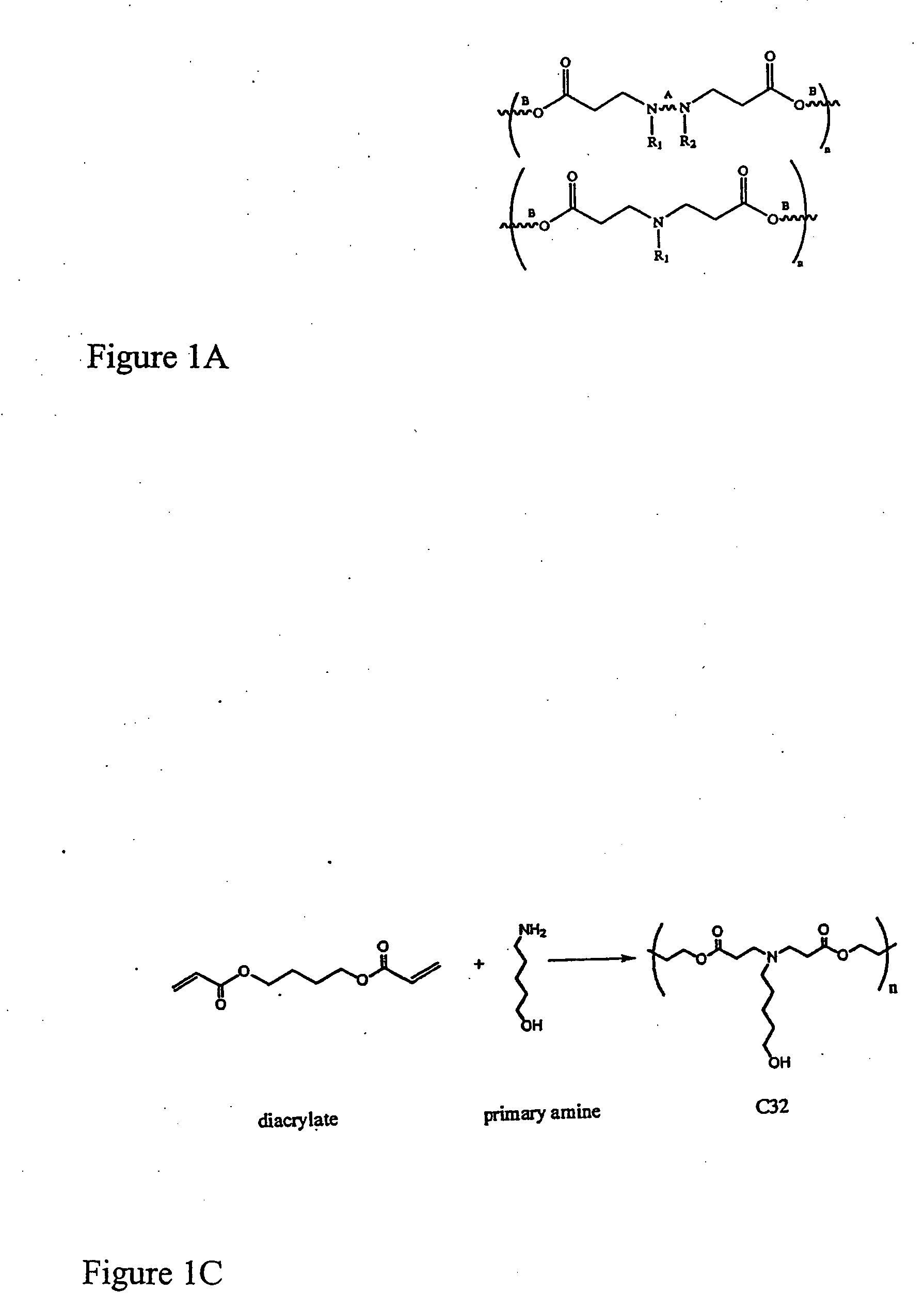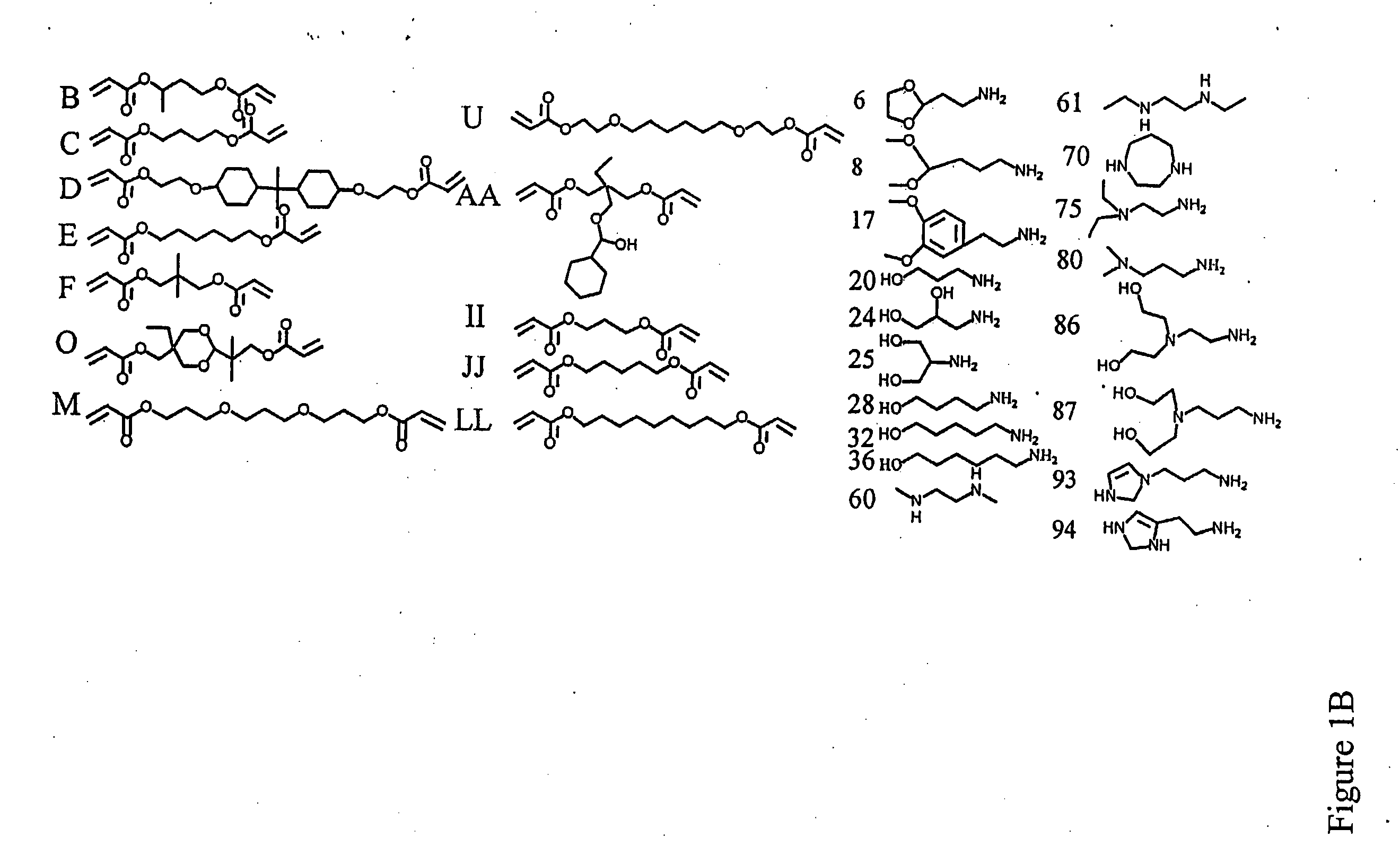Compositions and methods for treatment of hypertrophic tissues
a tissue and composition technology, applied in the direction of capsule delivery, synthetic polymeric active ingredients, gene material ingredients, etc., can solve the problems of reducing affecting the quality of life of patients, so as to reduce the size of the tissue
- Summary
- Abstract
- Description
- Claims
- Application Information
AI Technical Summary
Benefits of technology
Problems solved by technology
Method used
Image
Examples
example 1
Synthesis and Screening of a Library of Poly(β-Amino Esters)
[0223] Materials and Methods
[0224] Polymer Synthesis. Monomers were purchased from Aldrich (Milwaukee, Wis.), TCI (Portland, Oreg.), Pfaltz & Bauer (Waterbury, Conn.), Matrix Scientific (Columbia, S.C.), Scientific Polymer (Ontario, N.Y.), and Dajac monomer-polymer (Feasterville, Pa.). Six to twelve versions of each polymer were generated by varying the amine / diacrylate stoichiometric ratio. To synthesize each polymer, 500 mg of amino monomer was weighed into an 8 ml sample vial with Teflon-lined screw cap. Next, the appropriate amount of diacrylate was added to the vial to yield a stoichiometric ratio ranging from 0.6 to 1.4. A small Teflon-coated stir bar was then put in each vial. Polymers were then synthesized on a multi-position magnetic stir-plate residing in an oven at 1) 95° C. and solvent free, or 2) 60° C. with 2 ml DMSO added. High temperature synthesis was performed for approximately 12 hours, and low temperat...
example 2
C32-Delivered DNA Encoding Diphtheria Toxin (DT-A) Arrests Protein Synthesis in Prostate Cancer Cells In Vitro
[0233] Plasmid construction. pCAG / luc plasmid DNA, containing a firefly luciferase coding sequence regulated by a very strong, ubiquitously expressed promoter / enhancer was constructed as follows. A 1.7-kb fragment containing the luciferase coding sequence, released by digestion of pGL3-Basic vector (Promega, Madison, Wis.) with BglII and XbaI, was ligated to a 3.4-kb BamHI+XbaI fragment derived from pEGFP-1 (Clontech, Palo Alto, Calif.) to create pLucf. The plasmid pCX-EGFP (gift of J. Miyazaki, Kyoto U.), was digested with SalI and EcoRI to release a 1.7-kb fragment. This fragment, containing the CAG sequence, was ligated to a XhoI+EcoRI digest of pLucf to create pCAG / luc. CAG is composed of CMV enhancer sequence and the promoter sequence of the chicken β-actin gene.
[0234] The plasmid RSV / FRT2PSA.FLP / EGFP was constructed as follows. A 2-kb fragment containing Flp recombin...
example 3
In Vivo DNA Delivery to Tumor Xenografts Causes Tumor Regression or Inhibits Tumor Growth
[0243] Materials and Methods
[0244] Plasmid construction. pCAG / luc plasmid DNA was constructed as described in Example 2.
[0245] Xenograft experiments. DNA (either naked or complexed to C32 or PEI) was administered to 8-week old nu / mu male mice (Harlan, Indianapolis, Ind.) by intratumoral (I.T.) injection. Mice were maintained under standard laboratory conditions. To complex plasmid DNA to C32, the polymer was dissolved in dimethyl sulfoxide (100 mg / ml). DNA (50 μg) was suspended in 25 μl 25 mM sodium acetate buffer, pH 5.0, and mixed with C32 polymer (300 or 1500 μg), also diluted in 25 μl 25 mM sodium acetate buffer, pH 5.0. After incubation of the polymer / DNA mixture at room temperature for 5 minutes, 10 μl 30% glucose in PBS was added to the 50 μl polymer / DNA mixture.
[0246] Plasmid DNA was complexed to Jet PEI® (Qbiogene, Montreal, Canada) according to the manufacturer's protocol for in vi...
PUM
| Property | Measurement | Unit |
|---|---|---|
| Composition | aaaaa | aaaaa |
| Therapeutic | aaaaa | aaaaa |
| Cytotoxicity | aaaaa | aaaaa |
Abstract
Description
Claims
Application Information
 Login to View More
Login to View More - R&D
- Intellectual Property
- Life Sciences
- Materials
- Tech Scout
- Unparalleled Data Quality
- Higher Quality Content
- 60% Fewer Hallucinations
Browse by: Latest US Patents, China's latest patents, Technical Efficacy Thesaurus, Application Domain, Technology Topic, Popular Technical Reports.
© 2025 PatSnap. All rights reserved.Legal|Privacy policy|Modern Slavery Act Transparency Statement|Sitemap|About US| Contact US: help@patsnap.com



